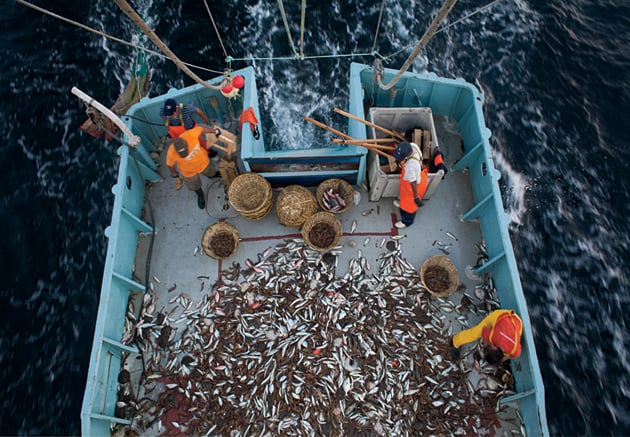Two Fish, One Fish, Don’t Fish, Ton Fish
How one community on the Sea of Cortez restored its fishery — and its economy — by stopping fishing altogether
Last fall, while reporting for Harper’s Magazine on the decline of fisheries in the Sea of Cortez, photographer Dominic Bracco and I had the chance to watch an industrial trawler pull in its catch in Guaymas, midway up the eastern coast of the Gulf of California. As I related in the story, most of the fish we saw were juveniles, because older fish have become increasingly difficult to find. It made me sad to watch baby sharks flop around on the trawler’s deck, slowly suffocating as the fishermen collected shrimp around them. But later a thought struck me: the fact that sharks were there at all meant not all hope was lost.
Nowhere is this more obvious than in Cabo Pulmo, on the southern tip of Baja. In 1995, this tiny fishing pueblo saw that its catches were shrinking to the point of crisis, so they took a strange step. With the help of the Scripps Institute of Oceanography, they closed off their own waters to fishing. Instead, they would try to make ends meet with tourism. So they created an underwater preserve that would give the area time to recover, and eventually attract scuba divers to their crystal-clear waters. “They suffered the first few years,” said Octavio Aburto, a scientist with Scripps. “They didn’t have any other choice. They implemented the park, had to pay taxes, and could not fish. But there wasn’t anything that tourists could see yet.”
Around the same time, 150 miles to the north, another town called Loreto tried a similar thing, with one difference — they allowed sport fishing, which most studies suggest isn’t a huge threat to fish populations. Its fishery, like Cabo Pulmo’s, had traditionally benefited from strong upwelling currents, which carry nutrients that nourish the entire food chain to the surface. But Cabo Pulmo featured an additional attractant for underwater creatures, one no other town on the Sea of Cortez could boast: a viable coral reef that could host complex ecosystems and attract bigger fish, as well as divers and snorkelers.
By 2009 the towns had found an answer to a question often asked by environmentalists and fishermen: “What would happen if we just stopped fishing?” Biomass in Cabo Pulmo’s waters increased 460 percent. Dip into the water and it’s hard to believe: grouper, octopus, and fish of every color swarm around the reefs. Black-tipped reef sharks, thought to be gone from the region, are back. Meanwhile, up in Loreto, Aburto says, the biomass stayed level even as fishing rods increased 400 percent. “Cabo Pulmo attracted fish,” he says, “Loreto attracted fishermen.”
Today, Cabo Pulmo is one of the great success stories among the so-called marine protected areas (MPAs). Those who dove the area in the 1970s say that though it’s still a shadow of what it was, the recovery is striking. It’s as if the fish so obviously absent from the Gulf of California were just waiting for a moment — a few years’ reprieve — to come roaring back. And with the fish have come tourists, who now bring a brisk business to the little town. In fact, the region recently managed to fight off a massive development proposal for Cabo Pulmo that would have turned it into another Cabo San Lucas.
“There were lots of different kinds of fish, different colors,” said Joel, a fisherman from Guaymas who had been flown out to Cabo Pulmo for a diving trip by a Mexican nonprofit called SuMar. “I started thinking, ‘This one is worth 2,000 pesos!’ And it’s still alive so that more people can come and go see it.” Back in his home waters, Joel fished an estuary that acts as a vital nursery to juvenile fish, which further depletes an already shriveled ecosystem. The day we fished with him he threw most of what he caught to the pelicans as we talked, saving only the prawns. There were so many people on the water he spent as much time faking out other boats in an attempt to draw them away from potentially good spots as he did fishing.
Despite the success of Cabo Pulmo, it’s still not clear that MPAs will genuinely restore the waters that surround them, let alone the Sea of Cortez as a whole. As it stands, fishermen tend to gather near the borders of the Cabo Pulmo preserve and “fish the line,” catching everything that leaves. Scientists like Aburto hope that once they gain a better understanding of the life cycles of various species, they can target the most important waters for protection, as they might on land — say at a breeding ground or an important migration stopover.
But Aburto was quick to tell me that it will take more than a map of mating grounds to reproduce Cabo Pulmo’s success. For one, not every strip of beach will attract tourists — in many places in the Sea of Cortez, the water is naturally the color of coffee. Also, there are only so many tourists to go around, and they can be capricious. But the biggest difference between success and failure was finding decisive leaders in fishing communities. “The question is,” he said, “who will have the courage?”



